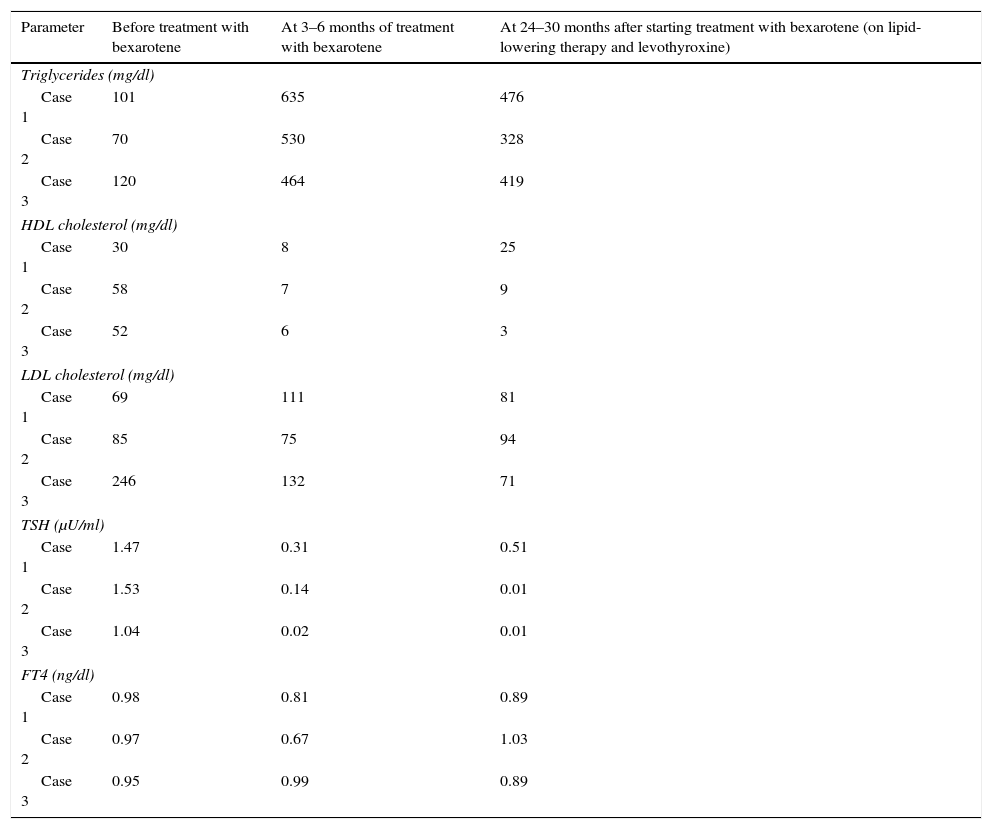Bexarotene is a synthetic selective X receptor rexinoide approved for the systemic treatment of cutaneous T-cell lymphoma. During treatment is very frequent the occurrence of hypothyroidism and severe mixed hyperlipidemia, both are reversibles and dose-dependent adverse events. Increase of triglycerides and LDL-cholesterol level (up to even higher levels have been associated with pancreatitis in some cases) is widely described (as is the case with other retinoids) but decrease in HDL-cholesterol is poored know. We review our experience with the use of bexarotene.
Material and methodsWe present a serie of 3 clinical report of patients treated with bexarotene in whose, in addition to these well-known adverse event, a serious lowering of HDL-cholesterol was observed.
ResultsThe 3 patients studied had metabolic complications like central hypothyroidism and severe mixed hyperlipidemia; with special emphasis on the sharp fall (mean decrease >83%) in the HDL-cholesterol level. Cholesterol lowering medication and substitutive hormonal replacement with levotiroxine resulted in an improvement of the biochimical parameters without reaching the correct goals.
ConclusionsBexarotene produce as predictable side effects severe mixed hyperlipidemia with marked decrease in HDL-cholesterol levels and central hypothyroidism, being the both reversible and dose-dependent. A reflection on the possible aetiological mechanisms and implications of this phenomenon are included.
El bexaroteno es un rexinoide sintético selectivo del receptor X aprobado para el tratamiento sistémico del linfoma cutáneo de células T. Durante el tratamiento es muy frecuente la aparición de hipotiroidismo e hiperlipidemia mixta grave, siendo ambos efectos adversos reversibles y dependientes de la dosis. La elevación del colesterol LDL y los triglicéridos (hasta unos niveles aumentados que incluso se han asociado a pancreatitis en algunos casos) está ampliamente descrita (al igual que sucede con otros retinoides), siendo el descenso del colesterol HDL menos conocido. Revisamos nuestra experiencia con el uso de bexaroteno.
Material y métodosSe presenta una serie de 3 casos de pacientes tratados con bexaroteno en los que, además de sufrir los efectos adversos bien conocidos, se observó un grave descenso del colesterol HDL.
ResultadosLos 3 pacientes estudiados presentaron complicaciones metabólicas en forma de hipotiroidismo central e hiperlipidemia mixta grave, con especial énfasis en el marcado descenso que experimentaron nuestros pacientes (descenso medio>83%) en las cifras de colesterol HDL. El tratamiento hipolipidemiante y hormonal sustitutivo con levotiroxina dio lugar a una mejoría de los parámetros, sin llegar a alcanzarse los objetivos.
ConclusionesEl bexaroteno produce, como efectos secundarios predecibles, una hiperlipidemia mixta grave con descenso marcado de los niveles de colesterol HDL e hipotiroidismo central, los cuales son reversibles y dependientes de la dosis. Se incluye una reflexión sobre los posibles mecanismos etológicos e implicaciones de este fenómeno.







